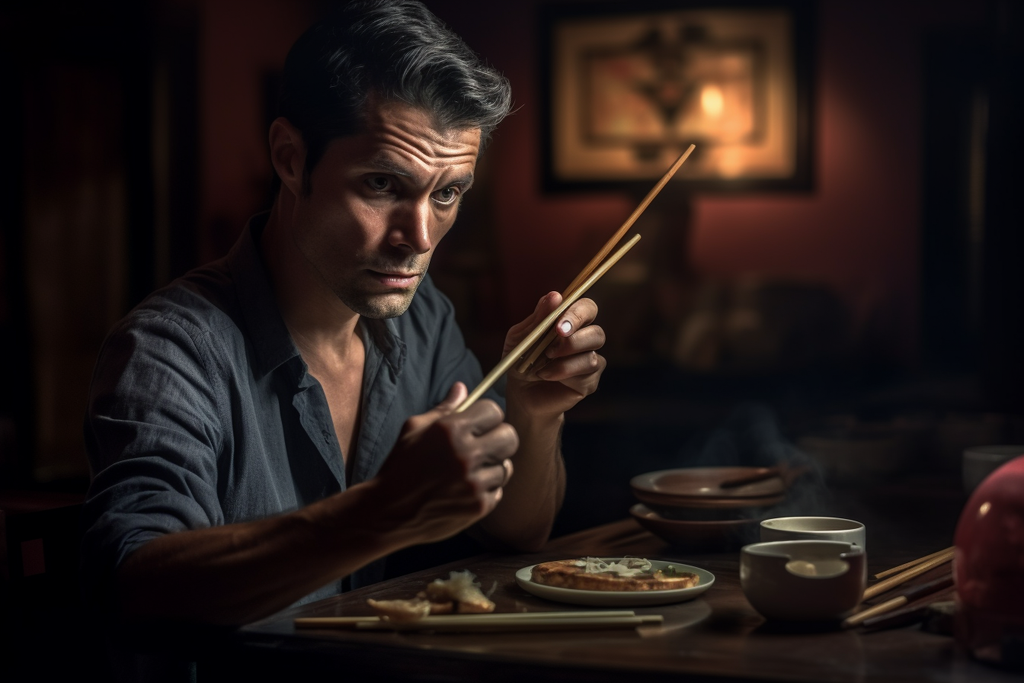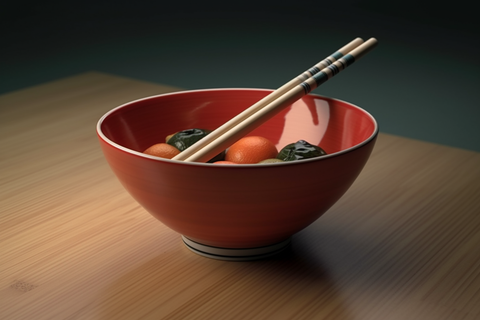Have you ever wondered why on earth many non-Asian peeps go all-in and use chopsticks to chow down? It's a phenomenon that's got tongues wagging and noodle lovers scratching their heads. Picture this: you're sitting in a hip eatery, surrounded by folks who ain't from Asian countries, and what do you see? People deftly wielding those slender bamboo sticks, gracefully grabbing bites of sushi, noodles, and everything in between. But why? Why ditch the trusty spoon or fork and take up this ancient eating utensil? Let's dive right in and uncover the delicious truth behind this culinary curiosity. Get ready to slurp up some tasty tidbits about the widespread use of chopsticks among non-Asian food enthusiasts. It's going to be chopstick-tactic!
The Popularity of Using Chopsticks: Exploring Why Many Non-Asian People Use Chopsticks When They Eat
Ever wondered why many non-Asian folks jump on the chopstick bandwagon when it's time to chow down? Well, let me spill the rice on this intriguing culinary tale.
You see, chopsticks are used by peeps from all walks of life to tackle their meals in a whole new way. It's not just about Chinese chopsticks or wooden chopsticks; it's a global affair. Instead of reaching for the fork and knife or the reliable spoon and chopsticks combo, they opt for these slender sticks that hold a special place in Asian culinary culture.
The history of chopsticks goes way back, my friend. Ancient civilizations in China, Japan, and beyond rocked these utensils long before the days of disposable chopsticks. Picture this: a pair of wooden or bamboo chopsticks, the silver or metal chopsticks made with finesse. They all serve one purpose – to pick up that scrumptious piece of food and make it dance from plate to mouth. Oh, but don't stick your chopsticks straight into that rice bowl! It's a no-no in Chinese culture, ya know.

Now, let's dive deeper into why chopsticks have become a sensation beyond East Asian shores. These nifty tools are more than just utensils; they're an integral part of Asian cultures. From Chinese restaurants to the ruins of Yin, where the earliest examples of Chinese writing were found, chopsticks have a history as rich as the flavors they encounter. So, the next time you find yourself at an Asian feast, place your chopsticks with care on the chopstick rest, and dig in! Chopsticks allow you to savor every morsel of Asian cuisine, from slurping noodles to enjoying a bowl of perfectly cooked rice.
And let's not forget the unspoken magic of using chopsticks to pick up food from a communal dish, where sharing becomes an art form. It's no wonder Asians use chopsticks with finesse; they've mastered the right way to wield these marvelous sticks.
Now, chopsticks come in all shapes and sizes. Many Japanese chopsticks are shorter for easy handling, while Koreans and Vietnamese have their unique versions. But here's the thing: chopsticks aren't just about practicality. They symbolize respect, togetherness, and the joy of good food. It's a cultural experience, my friend. But wait, there's more! Chopsticks prevent food from slipping away and save you from the embarrassing act of chasing that slippery shrimp across your plate. And did you know that using chopsticks can also help prevent poisoning? Yep, that's right! In ancient China, rulers used silver chopsticks as a precaution. If the food contained toxic substances, the chopsticks would turn black. Talk about a culinary safety net!
Throughout East and Southeast Asia, these slender utensils have become synonymous with Asian countries, including Thailand. So, the next time you're at a Thai joint, don't hesitate to embrace the chopsticks on the table and let them transport you to a world of delectable flavors. Remember, my friend, chopsticks are more than just eating tools; they're cultural ambassadors, bringing people together one bite at a time. So go ahead, pick up those chopsticks, and embark on a flavorful adventure that'll tantalize your taste buds and open your heart to the wonders of Asian cuisine. Chopsticks to chopsticks, we're in this together!
Etiquette and Cultural Significance: Understanding Chopstick Etiquette and its Importance in Asian Cultures
When it comes to chopstick use, a whole code of conduct'll make you bow in admiration. Picture this: people across Asia delicately maneuvering chopsticks as if they were seasoned maestros. Whether it's Korean chopsticks or Vietnamese chopsticks, the art of holding these slender utensils is a testament to their cultural roots. They're made of bamboo, wood, or even metal for those who crave a touch of elegance. And don't get me started on the plastic chopsticks that are as ubiquitous as the steamy bowls of Asian food.
Now, way back in the day, chopsticks were used for cooking before they found their way to our plates. But they've come a long way since then. These days, chopsticks are often the go-to choice for indulging in delectable bites of Chinese food, and they've become a staple in households and restaurants alike. But here's the kicker: there's a right way to use chopsticks, my friend. It's not just about grabbing a pair and going wild. Oh, no! It's about finesse and precision, and the styles of chopsticks vary from place to place. Early chopsticks were humble, made of bamboo or wood, and now we have sleek stainless steel versions that add a touch of class to any meal. So, next time you find yourself faced with a bowl of rice or a plate of piping hot noodles, put that fork aside and embrace the chopstick culture. And guess what? Thai people are no strangers to the chopstick game, either. It's a universal language that transcends borders, connecting us through the joy of good food and shared experiences.
So, the next time you're offered chopsticks at an Asian feast, don't shy away. Grab those two chopsticks, savor each bite, and let the flavors transport you to a world where chopsticks are more than just utensils. They're a symbol of cultural heritage, a connection to our roots, and a way to pay homage to the rich tapestry of Asian cuisines.
From History to Present: Tracing the Origins and Evolution of Chopsticks in Different Asian Cultures
From the ancient realms of China to the bustling streets of Japan and beyond, the story of chopsticks unfolds like a riveting saga. These humble utensils, made of bamboo or wood, have witnessed empires rise and fall while silently serving their purpose on dinner tables across Asia. They've come a long way since their early days, evolving into sleek and stylish metal chopsticks made of stainless steel.
The use of chopsticks in Asian cultures goes beyond practicality. It's a dance of tradition and cultural identity, connecting generations and preserving the essence of their culinary heritage.
Each region, from Chinese cuisines to the vibrant flavors of Korea and Vietnam, adds its unique twist to chopstick use. It's like a symphony of flavors conducted by these slender sticks. The history of chopsticks is a testament to the beauty and diversity of Asian cultures, and it's time to embrace it with open arms, an empty stomach, and a heart full of curiosity.
Learning to Use Chopsticks: How and Why Non-Asian Individuals Choose to Learn and Master the Art of Using Chopsticks
Let's unravel the mystery of why non-Asian folks take up the challenge of learning and mastering the art of using chopsticks. It's like embarking on an adventurous quest to conquer a whole new way of enjoying a meal. Picture this: people from all walks of life, from all corners of the globe, embracing the chopstick culture with gusto. But why, you ask? Well, something is intriguing about the way Asian cultures use chopsticks. It's a symbol of tradition, a connection to their roots. And so, non-Asians find themselves drawn to this fascinating world, eager to navigate the chopstick terrain.
Learning to use chopsticks is like learning a new language, a language of flavors and techniques. It's a journey that starts with holding those slender sticks, be it a pair of wooden chopsticks or the sleek elegance of metal chopsticks made of stainless steel. They're not just utensils but a gateway to a whole new culinary experience. And as you venture into this realm, you discover that chopsticks are made of bamboo, a material that carries the essence of Asian traditions. Throughout Asia, from China to Japan, chopsticks are commonly used for a variety of dishes, be it savoring a bowl of rice or gracefully slurping noodles. It's a skill that opens doors to a world of taste and appreciation. So, why abandon the trusty fork and delve into chopstick territory?
Well, there's a sense of adventure, a desire to embrace the customs and traditions of different cultures. It's like a passport to authenticity, an invitation to savor Asian delicacies in their truest form. And let's not forget the practical aspect; chopsticks provide a certain finesse and control that can't be replicated with a fork. They allow you to appreciate the nuances of food, to pick up each morsel with precision. Plus, it's hard to resist the allure of chopsticks, those elegant sticks that make any dish look even more tantalizing.

Sharing Food and Building Connections: The Symbolic Gesture of Passing Food with Chopsticks in Cross-Cultural Dining Experiences
Chopsticks held with grace, moving from plate to plate, a silent invitation to partake in the communal feast… It's a beautiful sight, my friend. You see, chopsticks are more than just utensils; they're a bridge between cultures, a way to share food, stories, and experiences. It's a reminder that we're all connected, regardless of our backgrounds. In many Asian cultures, passing food with chopsticks is a tradition that holds deep significance. It's a gesture of generosity, a symbol of hospitality. And there's an art to it, a rhythm that flows from one person to another. You grasp the chopsticks, savor a morsel, and then pass it along to your dining companions, creating a bond that goes beyond the flavors on the plate. It's a way of saying, "Here, try this.
Experience what I'm experiencing." It's a moment of unity, a celebration of our shared humanity. So, the next time you find yourself amid a cross-cultural dining experience, don't hesitate to embrace the chopsticks. Let them guide you through a world of flavors and connections. Share food, share stories, and build connections that transcend borders. Chopsticks, my friend, they're not just tools; they're conduits of friendship and understanding.
Summary
In conclusion, the phenomenon of many non-Asian people using chopsticks when they eat is a testament to the power of cultural exchange and appreciation. It's not just about picking up food; it's about embracing traditions, flavors, and connections. Chopsticks have become more than just utensils; they're a symbol of cultural curiosity and a desire to immerse oneself in the rich tapestry of Asian cuisines. From the humble beginnings of bamboo and wooden chopsticks to the sleek elegance of metal and stainless steel, these slender sticks have woven their way into the fabric of global dining experiences.

Whether it's the joy of eating rice or the art of handling noodles, chopsticks offer a unique perspective and a sense of unity. They transcend borders, inviting us to step out of our comfort zones and explore the world through our taste buds. So, let's continue to pass the chopsticks around, sharing food, stories, and moments of connection. After all, food is not just sustenance; it's a language that unites us all. So, next time you're faced with a choice between a fork and chopsticks, remember the journey that chopsticks have taken and the cultural significance they hold. Embrace the chopstick culture, one bite at a time.
People Also Ask
Why do many non-Asian people choose to use chopsticks when they eat?
Well, there are a few reasons why folks from different backgrounds embrace the chopstick culture. Firstly, it's a way to experience and appreciate Asian traditions and cuisines. Secondly, using chopsticks offers a unique and precise way of picking up food, especially when it comes to enjoying noodles or delicately maneuvering rice. It's like a dance of flavors, adding a touch of elegance to the dining experience.
Are there any advantages to using chopsticks over a fork?
Absolutely! Chopsticks provide a certain finesse and control that can't be replicated with a fork. They allow for more delicate handling of food, ensuring that each bite is savored and enjoyed. Plus, chopsticks tend to be lighter and easier to handle, making them a convenient choice for many when it comes to enjoying Asian dishes.
How did chopsticks become so popular outside of Asia?
It's quite a fascinating journey! As globalization spread, so did the appreciation for different cultures and their cuisines. Chopsticks, being an iconic symbol of Asian dining, started to gain popularity among non-Asian folks who wanted to explore new flavors and embrace cultural diversity. The allure of chopsticks, whether they're made of bamboo, wood, or even stainless steel, captured the imagination of food enthusiasts worldwide, leading to their widespread use in cross-cultural dining experiences.
ABOUT THE AUTHOR
Aleksandra Djurdjevic
Senior Content Creator
Aleksandra Djurdjevic is a senior writer and editor, covering snowboarding, skiing and trends in outdoor winter activities. She has previously worked as ESL teacher for English Tochka. Aleksandra graduated from the Comparative Literature department at the Faculty of Philosophy in Serbia. Aleksandra’s love for the mountains, getting out in the snow on her board, season after season, seeking wild snow adventures across the globe helps her continue to be a top expert at CSG.






